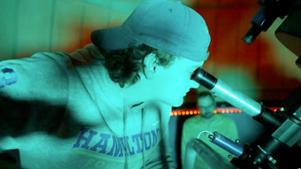
The planets orbiting stars outside our solar system are known as exoplanets. Lark joined in the search for exoplanets roughly two years ago, adding Hamilton to dozens of other institutions nationwide participating in the NASA-funded search project.
“The fact that we can find new planets, or at least confirm their existence, is amazing,” Miralles said. “We’re helping to map the sky, and that’s helping us understand where we live in the universe.”
The Transiting Exoplanet Survey Satellite (TESS), a NASA satellite, observes stars for 30 days and determines which ones may have an exoplanet based on recorded brightness abnormalities. These abnormalities, however, could also be due to another star. Sometimes, stars orbit around each other in a binary star system. One star crossing in front of the other may cause the decrease in brightness that is typical with exoplanets. It is up to ground-based astronomers, like the Lark team, to more definitively determine that the TESS-recorded eclipse is caused by an exoplanet.
Using information collected from TESS, the Lark team conducts further observation on a star system during its eclipse. Lark, Ryan, and Miralles take telescope images of the star over the course of the night. After processing these images, the three end up with a graphed light curve that reveals important information about the star’s eclipsing object.
“The more we know about the universe, the better,” Ryan said. “These light curves are our evidence that there is an exoplanet.”
By generating light curves with red and blue light filters, the team can rule out a star as the eclipsing object. Stars produce their own light with their own color distinctions. Therefore, when a star eclipses another star, it will create different red and blue light curves. Exoplanets, on the other hand, simply block out a star’s light, without producing their own, creating the exact same red and blue light curves. Once an eclipsing object is determined to be an exoplanet, the research team can also use the light curves to determine how quickly an exoplanet is moving, its general size, density, mass, and radius.
Ryan Hunt ’23
Majors: Physics and Economics
Hometown: Hamilton, NY
High School: Hamilton Central School
Alvaro Marin Miralles ’23
Majors: Physics and Math
Hometown: Alicante, Spain
High School: CEU Alicante
Lark anticipates continuing this research as long as TESS is still finding new target star systems. That means another five to 10 years of exploring the universe.
“With this work, we can touch planets in a sense,” Lark said. “We can discover new worlds and understand planets other than our own. I’m very motivated by that.”
Posted June 27, 2022



